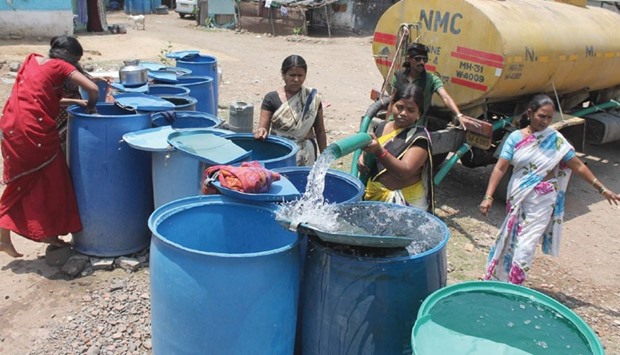
A woman fills containers from a water tanker in Nagpur yesterday. Nagpur and many other parts of Maharashtra are facing an acute shortage of water.
India’s crucial monsoon rains are expected to be above average in 2016, the weather office said yesterday, easing fears over farm and economic growth after two straight droughts hit rural incomes and agricultural output.
Rains in 2016 would be 106% of the long-term average, Laxman Singh Rathore, chief of the India Meteorological Department, told a news conference.
Rathore said the monsoon rains could be above average as El Nino - a warming of the eastern Pacific Ocean that can lead to dry spells in South Asia - is fading and giving way to La Nina in which the same waters cool.
The country is likely to get surplus rainfall during all four monsoon months of June to September, he said.
The monsoon delivers 70% of India’s annual rainfall. It is critical for the country’s 263mn farmers and their rice, cane, corn, cotton and soybean crops because nearly half of its farmland lacks irrigation.
Bumper rains can spur farm and economic growth and boost rural demand for gold, cars, motorcycles, refrigerators and fertiliser. Two-thirds of India’s population depends on farming for its livelihood.
Plentiful rains could also encourage the Reserve Bank of India to cut interest rates after the central bank this month eased its repo rate by 25 basis points to its lowest in more than five years.
“If indeed we end up having a better-than-normal monsoon, and spatial distribution of monsoon and production indicators point to a normal year, then the RBI’s comfort for another rate cut will increase,” said Gaurav Kapur, senior economist at Royal Bank of Scotland in Mumbai.
In the second forecast in June the weather department will provide regional and monthly rainfall forecasts, Rathore said, adding the monsoon rains are likely to hit the Kerala coast around the usual time.
A normal or average monsoon means rainfall between 96% and 104% of a 50-year average of 89cm during the four-month season from June, the weather office says.
Two straight years of drought in India - for only the fourth time in over a century - have sparked anger among farmers against Prime Minister Narendra Modi.
They blame his government for being slow in reaching out to them after drought ravaged their crops in 2014 and 2015, making a mockery of his election promise that they would make a 50% profit on their cost of cultivation.
The farm vote will be critical in determining the fortunes of Modi’s Bharatiya Janata Party (BJP) when the big rural states of Uttar Pradesh and Punjab go to the polls in the first half of next year.
Key pulses growing in central states are likely to get better rainfall in 2016, but northeast India and southeast part of the peninsula could get lower rainfall, Rathore said.
Pulses and products inflation rose 38.30% in February, the highest rate posted among all items in the CPI basket, as production fell due to the first back-to-back drought in nearly three decades. Meanwhile, Latur in Maharashtra which is in the grip of a severe drought yesterday received a ‘water train’ sent by Indian Railways as a humanitarian gesture.
The train is carrying around 550,000 litres of drinking water.
The railways on Monday sent the 10-wagon train from Miraj in western Maharashtra for Latur city in the Marathwada region.
The train was welcomed with cheers and a sense of relief by the people as tight security was deployed around the railway station.


